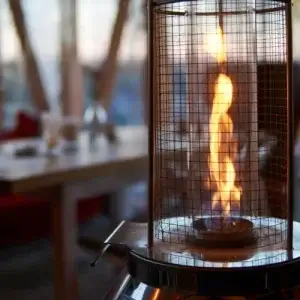Home / Compare Energy / Small business gas plans
Small business gas plans
Compare the Market doesn’t currently offer energy plans for businesses, but visit us again in the future for any updates. If you’re a residential customer, you’re still able to compare both electricity and gas, provided you live in an eligible state or territory and meet the relevant eligibility criteria.



Key takeaways
Gas is an essential part of the day-to-day working of many businesses, and a convenient way to save money for others. Our guide will explain the types of gas available, how to get connected and tips for managing your bill.
- There are two types of gas available, natural gas and Liquid Petroleum Gas (LPG), and which is best for your businesses will depend on which type of gas is available to you and the type of business you run.
- If your property needs gas but is not currently connected, it may be possible to organise a new connection for your property for a fee.
- Depending on your circumstances, you may be able to claim back some of your energy expenses on your tax return.
About gas for small businesses
Gas or electricity: What’s best for me?

In the long term, gas can be a potentially cheaper energy source than electricity.
When it comes to electricity or gas, electricity is more common, but businesses of all sizes may still need gas for certain appliances. For example, most hospitality businesses will use gas ovens and cooktops because they’re quicker to heat up, provide more even heating and are more cost-effective than their electric counterparts. Typically, a business might use gas for:
- Boilers
- Ovens and stoves
- Incinerators
- Indoor and outdoor heating
- Air conditioning
- Waste treatment
- Other industrial uses.
Depending on the availability of gas in your area, businesses that rely on electricity may be able to switch to gas for some appliances. While gas heaters or other gas appliances may have more expensive upfront installation costs, they’re typically cheaper to run and a valuable long-term investment for business customers.
If you decide to use both energy sources, you may consider a business electricity and gas bundle or ‘dual fuel’ plan, a common energy solution for many Australians. Keep in mind, you can’t run a business solely on gas, which means, you will need an electricity plan. In addition, combined energy plans are not always the cheapest option, so it’s generally recommended you check gas and electricity prices separately and compare across different providers.
Should my small business use gas?
Depending on your energy needs, you may find it useful to use gas appliances when the option is available to your business. Manufacturing, hospitality and even offices may rely on gas for their day-to-day operation, depending on the needs of the business.
If you’re considering switching to gas, it’s important to work out how long you’ll need to run your gas appliances each day as this will help you weigh up the costs and decide whether to switch. For example:
- A bakery may use gas in the early hours of the morning when making fresh bread.
- Office spaces that use gas for heating or cooling may need gas for the nine-to-five workday, but not weekends or nights.
- A restaurant may only need gas for the afternoon and evening when they open for business.
Large businesses, like those in the industrial sector, are the biggest consumers of gas in Australia, as they may operate 24/7 and use heavy-duty machines that require a lot of power.
What’s the difference between LPG and natural gas?
If your business uses liquid petroleum gas, you’ll have one or more pressurised containers, bottles or storage tanks somewhere on the property that are connected to the building. They feed gas directly to the appliances that need it, but once they run out or get low, you’ll need have them refilled.
On the other hand, natural gas is fed through a gas line under the ground and is part of a wider network. Appliances are connected to it via pipes in the building.
A common example of how a business may use LPG is in mobile outdoor heaters, as these need their own bottle and they can’t be connected to pipes. LPG bottles can also come in a range of sizes to suit different needs, including storage tanks over 100 or 200 kilograms in size.
Are there business tariffs specific to gas?
Just like electricity, gas has tariffs you have to pay (tariffs being the price you’re charged for the energy you use). Unlike electricity (which may have solar feed-in tariffs, time of use and controlled loads), gas tariffs are relatively simple in comparison.
Your gas bill splits your tariff into two parts.
- The daily supply charge is usually a fixed rate that covers the cost of supplying your business with energy.
- The usage charge (sometimes known as the variable charge) is the amount you pay depending on how much gas your business consumes.
Gas can be charged at a “flat” single rate – the same price no matter the time of day or year – or a “blocked” single rate, where you pay one rate for the first part of your gas usage, then switch to a second rate for the next part. These “blocks” can be daily, monthly or even quarterly. Some providers in Victoria may also have seasonal gas rates if you live in the Multinet or Ausnet distribution areas. This means that you get charged more during certain seasons, such as winter or summer.
Who is my gas distributor?
Distributors maintain the network, while providers sell and bill the gas and electricity plans. If you already have a business gas plan, your distributor’s contact information will be listed on your natural gas bills, usually in case of an issue with your gas supply.
Getting gas connected to your property
How do I know if natural gas is connected to my business premises?

If you’re unsure whether there’s an existing gas supply at your business address, you can check online with your distributor by visiting their website and entering your address, or by emailing or calling them.
If you’re a new customer wanting a gas connection, contact your gas provider to arrange the new connection with your distributor. If you’re eligible for a gas connection but your business isn’t already connected to the pipeline, you can get a service line installed. There may be costs involved, and the distributor will carry out the installation and connection work.
How do I get a gas meter installed at my business premises?
As with your electricity meter, you’ll need to apply with your provider first. There are two types of gas meter installations:
- Service line. Installations that take place when you’re not connected to an existing gas pipeline.
- Meter only. Solely the gas meter setup.
Keep in mind that a service line installation can take from 5 to 30 business days (or as long as 8 weeks in Western Australia), while meter-only installations may only take up to 3 business days.
What if my business changes address and I need natural gas connected to the new property?
If you’re moving to a new location, you need to tell your provider in advance about the move so they can check for an existing gas connection or, if not, whether the building can be connected to gas. If gas is available, let them know what date you wish to move in ahead of time. Allow at least three business days before you move for your gas to get connected.
Do I need to be there when my business gets gas connected?
In most Australian states, you don’t need to be present on connection day unless your meter is:
- Located inside your business premises
- Behind a locked gate
- Requires safe access.
In these cases, you can either be there on the day or authorise a person aged 18 and above to be present on your behalf.
Will I be charged if I disconnect or reconnect?
Your distributor may charge you a fee and bill it to your energy provider, which they will likely add to your next bill. Refer to your energy offer summary to check whether you’re responsible for this fee.
Understanding my gas bill
How do I read my gas bill?
A typical natural gas bill lists your account details, the amount due and the payment due date on the front page, and includes the payment slip at the bottom. The back page of the bill normally shows your next scheduled meter reading and lists your tariff type, usage and supply details, energy charges (including and excluding GST) and your payment options.
You can find the full guide on how to read your energy bills here.
Something’s not right with my bill. How can I get a meter reading?
If you feel that you’ve been incorrectly billed or want to check a current meter reading, call your energy provider. They’ll arrange a special meter reading at your business premises. If it turns out you were correctly billed, your provider may charge you a fee for this meter reading.
Sometimes, you may receive an estimated gas or electricity bill, which will be based on your previous energy usage. Generally, this happens if the meter was unable to be read or the meter reader didn’t share the information with your provider. If this is the case, you should contact your provider for options.
Can I claim my business gas bills as a deduction for my next tax return?
The eligibility of being able to claim depends on the nature of your business and how you use energy at your premises. Because all small to medium-sized businesses operate differently, it’s worth reading the relevant information from the Australian Taxation Office.
If you run a business from your home, you’ll need to calculate the energy expenses related to your home office. Make sure you store a copy of each business energy bill for taxation purposes.
Are there any energy incentives available for small businesses?
Although Tasmania and the Western Australia currently don’t have incentives for small businesses to increase their energy efficiency and lower emissions, many other states and territories do:
Australian Capital Territory (ACT)
Small to medium businesses operating in the ACT may be eligible through the Sustainable Business Program.1 The ACT Government offers an energy assessment of your business and potential access to energy efficiency upgrade rebates.
Victoria (VIC)
If you’re moving to or your business is currently situated in Victoria, your business may be eligible for the Victorian Energy Upgrades (VEU) program.2 This program gives business discounts and rebates on energy-efficient electric and gas appliances and services, benefiting businesses of all sizes, with the exception of Victoria’s largest energy using businesses.
New South Wales (NSW)
In NSW, the Energy Savings Scheme provides incentives for office buildings to improve their NABERS energy rating, although any assistance is specific to your site and can vary.3
South Australia (SA)
For businesses and households, South Australia has the Retailer Energy Productivity Scheme (REPS) to encourage energy saving.4 Energy customers in SA can access REPS by contacting any obliged retailers (regardless of which retailer they’re with) or contacting the activity providers. Activities may include the purchasing or installation of energy efficient appliances, water heating, lighting and more.
Queensland (QLD)
The PeakSmart air conditioning program allows for rebates for customers with either Energex or Ergon Energy as their distributor when purchasing an air conditioner or converting their current one to PeakSmart.5 Queensland also has the ecoBiz support program to assist businesses with saving money on their energy, water and waste bills.6
Northern Territory (NT)
Depending on your eligibility, if you have a business if the Northern Territory you may be able to get advice on being energy efficient as well as grants for efficiency improvements and renewable energy systems.7 The purpose of the Smarter Business Solutions program is to reduce day-to-day energy, waste and materials costs for businesses in NT.
Meet our energy expert, Meredith O’Brien
As the Head of Energy at Compare the Market, Meredith O’Brien believes in educating Australian customers about the everchanging gas and electricity market so they can adjust their energy usage habits and get the most out of their energy plans.
Meredith has six years within the energy industry, following 15 years of experience in financial services and is currently studying a Master of Business Administration. Meredith is a dedicated customer advocate who is passionate about empowering Australians to find the right products to suit their needs by removing the confusion from comparing.
1 ACT Government. Sustainable Business Program. Accessed November 2023.
2 Victoria State Government. Victorian Energy Upgrades for businesses. Last updated March 2023. Accessed November 2023.
3 Australian Government. Department of Climate Change, Energy, the Environment and Water. Building energy efficiency incentive. Accessed November 2023.
4 Essential Services Commission of South Australia. Retailer energy productivity scheme (REPS). Accessed November 2023.
5 Queensland Government. Energy efficiency in your home. Last updated September 2023. Accessed November 2023.
6 Department of Climate Change, Energy, the Environment and Water. Australian Government. EcoBiz energy-efficiency and sustainability assistance. Accessed November 2023.
7 Department of Climate Change, Energy, the Environment and Water. Australian Government. Business efficiency assistance. Accessed November 2023.

